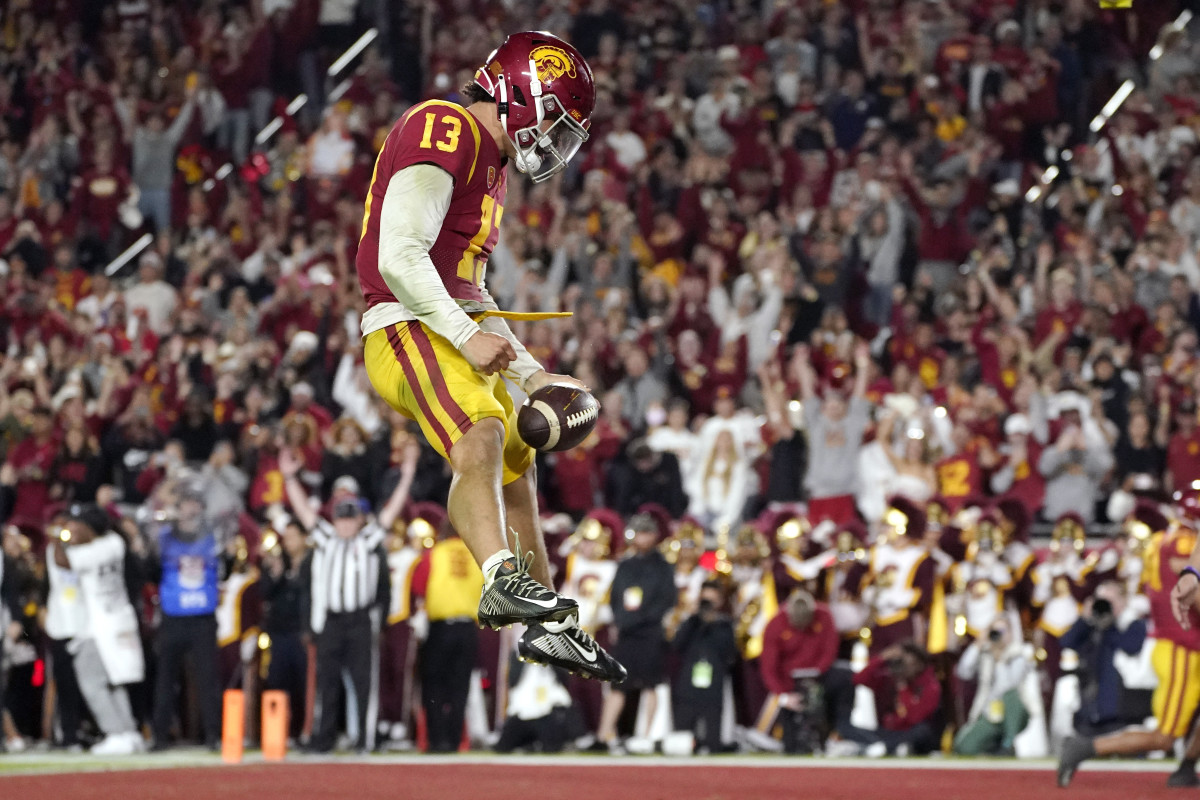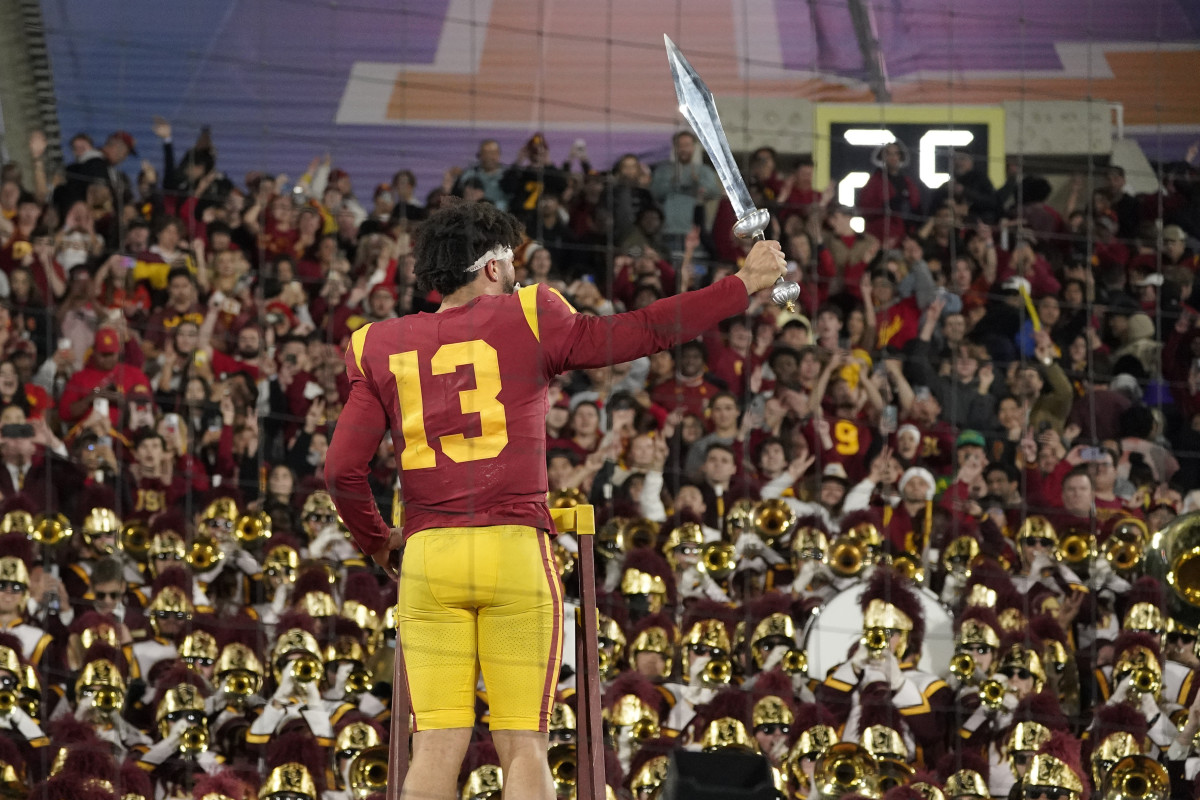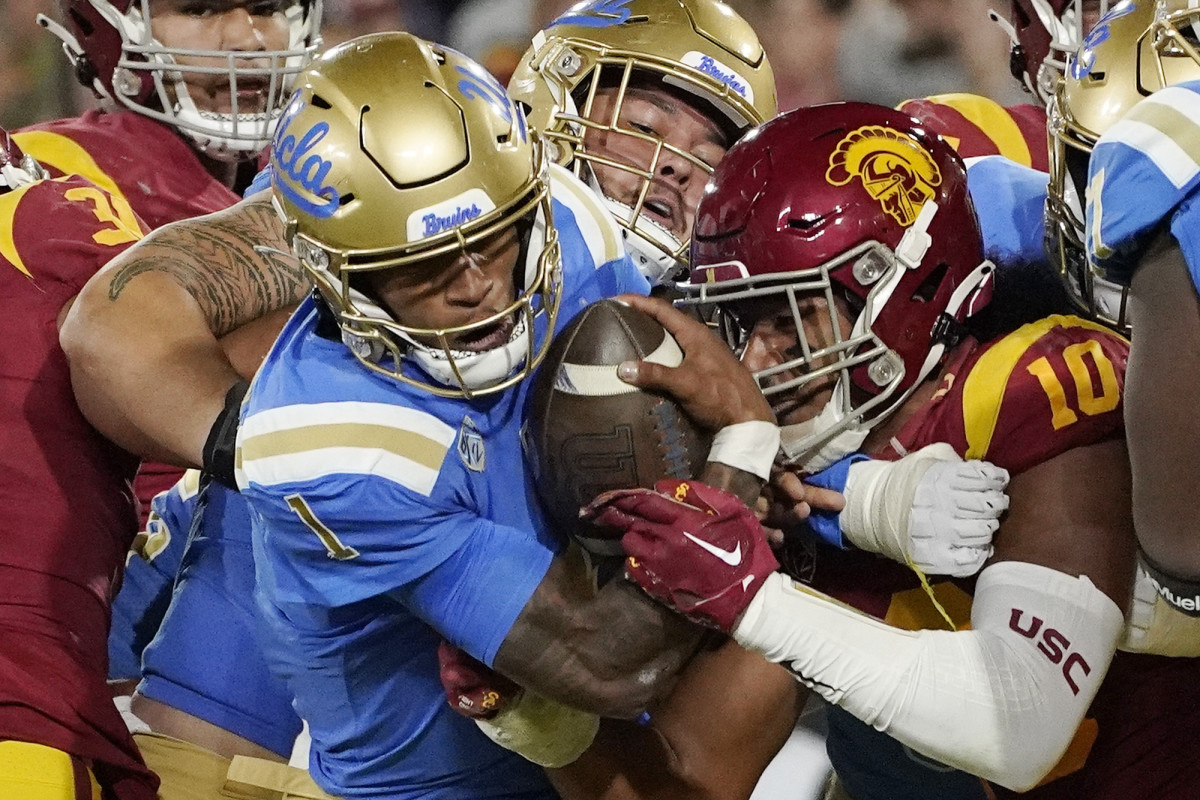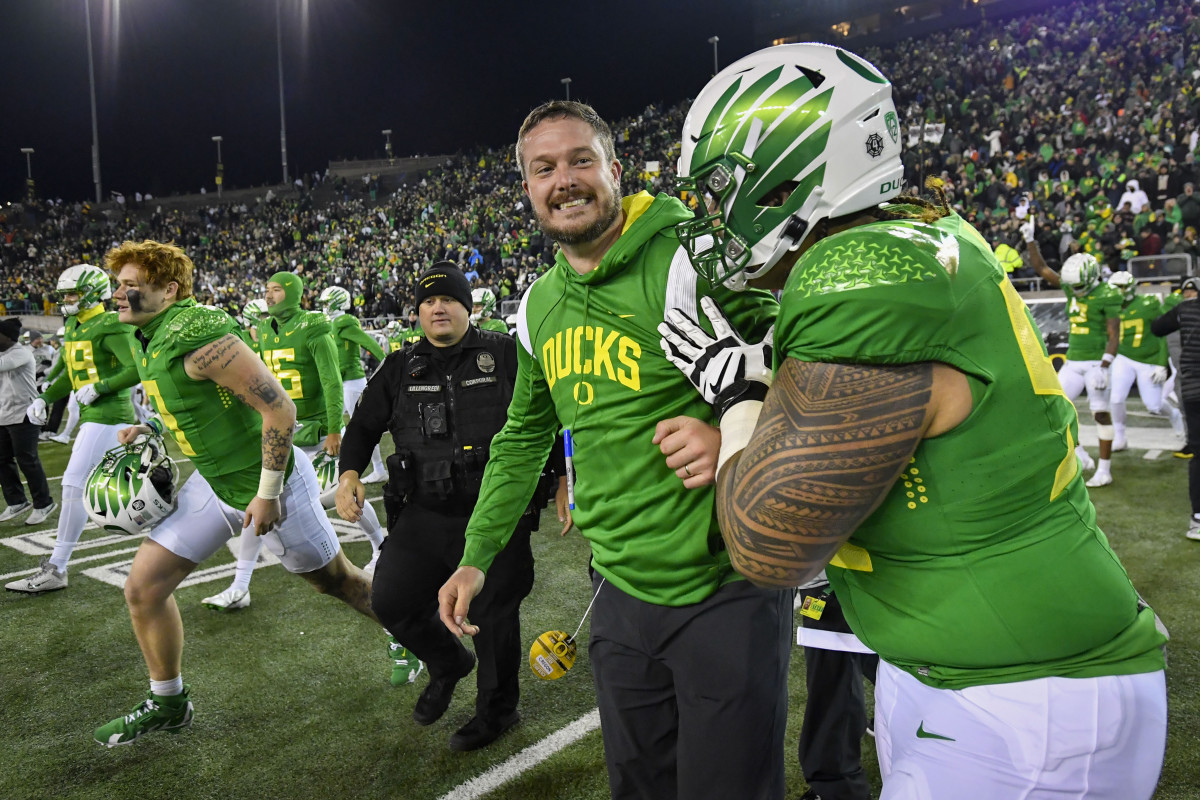Pac-12's Resurgence to Relevance on Full Display in USC-Utah Title Game
LAS VEGAS — It is the best-worst-weirdest of times for the Pac-12 Conference, which comes together in the desert this week for a veritable Victorian Era drama that will play out on a football field.
There is pride. After toiling for years as the least powerful of the Power 5 football conferences, the Pac-12 is having a rebirth. It currently has six teams ranked in the top 17 in the AP poll for the first time in its history. The league has depth and talent and excellent coaching and dynamic quarterbacking. Correspondingly, it has a great shot at its first College Football Playoff bid since 2016.
And there is prejudice. The school carrying the Pac-12’s CFP hopes into the Friday night conference championship game is No. 4 USC, which along with crosstown co-conspirator UCLA is dumping the league for the Big Ten come 2024. (Unless the Bruins get caught in a Board of Regents bear trap on the way out. More on that later.) As Pac-12 standard bearers go, the Trojans aren’t the ideal choice. The two Los Angeles schools have engendered deep animosity by imperiling the conference they are leaving.

Charles Dickens’ opening sentence of A Tale of Two Cities might as well have been written about the Pac-12 in 2022: “(I)t was the season of Light, it was the season of Darkness, it was the spring of hope, it was the winter of despair, we had everything before us, we had nothing before us…”
A playoff contender has been desperately sought by the Pac-12, which has the fewest CFP appearances of any Power 5 conference (just two, Oregon in 2014 and Washington in ’16). But did it have to be these guys, just five months after making their departure from the league official?
“I’ve been incredibly clear since announcements were made on June 30th that as long as those two schools are in our conference, we’re going to get behind them and help them be successful,” Pac-12 commissioner George Kliavkoff says.
But the conflicting emotions are real. This is an exercise in staying present and taking what the league can get before it’s gone.
“I’ve just honestly put my head in the sand and not thought about what’s to come,” says Fox TV analyst and former Washington Huskies quarterback Brock Huard, who will be on the call for the game Friday. “I don’t mean to dodge it, but I’m living in the moment. I know (the Trojans) are leaving eventually, but while they’re here the league can reap the attention and the revenue and the ratings eyeballs that come with USC being good.”
There are substantial things to be gained by the Pac-12 from having a team in the playoff — $6 million in league revenue, plus a huge jolt of exposure and a renewed infusion of respectability. The annual storyline about trailing the rest of the Power 5 could be put to bed for the moment, at least. And one ripple effect from a West Coast playoff team could be fewer California kids leaving the region for college. (Of the Class of 2023 top 15 players in the state according to rivals.com, three have committed to Pac-12 schools, five to SEC schools, three to Louisville and two to Notre Dame.) If they believe they can play for a national title while staying home, that’s good for everyone in the Pac-12.
(That premise got a formal jolt of adrenaline Thursday morning with the official announcement that the CFP will expand to 12 teams in 2024, with the six highest-rated league champions guaranteed spots. In the Pac-12’s first season without USC and UCLA, it will be a virtual lock to have a playoff team.)
But, still, the premise of USC’s rising tide floating all boats has an expiration date. And thus common sense and human emotion dictate that the vast majority of the conference will be rooting for Utah Friday night. Washington, which will go to the Rose Bowl if USC wins and grabs the playoff spot, will not. And perhaps not UCLA (although rooting for USC does not come easily in Westwood, at least prior to the schools making their escape pact). Everyone else likely lines up behind the Utes.

They are the sense and sensibility of the Pac-12, with an old-school coach in his 18th year in Kyle Whittingham and a playing style that added some meat-and-potatoes heft to a lightweight league in recent seasons. They are the antithesis of L.A. sizzle in many ways. And they are proud Pac-12 members (for now, because you never know).
“It’s exciting to play USC for any team, but I think it’s good for Utah to play USC,” Utes athletic director Mark Harlan says. “It always brings out that extra step in us. I think we all in the league have worked hard to support our programs to have the opportunity to get back in the College Football Playoff. We’ve worked very hard to be back in this position. I think it’s exciting in that way.
“Like everybody, I was shocked when the L.A. school announcement came down. I was concerned about our league, about the University of Utah and how this will all look. But that’s been a journey of a few months, and I think of the incredible job our commissioner has done. I feel a lot better today than I have. I still am disappointed we’re losing schools, but I also know the 10 that are left are pretty special, and I think there will be an opportunity to add more, if they make sense.”
That’s down the road. For now, the sequence of events in terms of assessing the future of the Pac-12 is as follows:
- UCLA’s Board of Regents is scheduled to meet (again) on Dec. 14, at which time it is expected to either sign off on the Bruins’ departure for the Big Ten or throw some sort of wrinkle in the plan. The wrinkle could be requiring UCLA to share some of its massive future Big Ten revenue to fellow UC System and Pac-12 brother Cal-Berkeley. Or it could pause the proceedings. Or it could be as drastic as roadblocking the move altogether. While the last of those options would seem unlikely, the longer this goes the more you wonder (and it’s been going for a while now).
- The league will come to a media rights agreement, likely sometime in 2023. Kliavkoff points out that with the Big 12’s new deal done, the Pac-12 has the floor to itself and there is no rush for his conference to finalize anything. Conference sources said that given the likelihood of new, non-linear broadcast partners in the deal, this is less of a conventional process than others and requires a lot of consideration. And as Kliavkoff points out, “The price is not going to go down. It’s going to go up.”
* After that deal is done, the conference can gauge whether it wants to expand. Kliavkoff noted Thursday that bigger is not automatically better, and that a membership of 10 to 12 might be preferable to 16. The commonly mentioned schools that could be targeted start with San Diego State and SMU. Other Mountain West schools would love to get onboard, with UNLV perhaps best positioned while still being a terminal football underachiever. Gonzaga is making inquiries with multiple conferences as a non-football member.
Before all that, though, there is this football game Friday. Events elsewhere have conspired to make the Pac-12 title contest the most interesting and impactful of all the conference championship games in playoff terms. The SEC and Big Ten games are almost non-events—No. 1 Georgia and No. 2 Michigan can survive a shocking upset loss and still make the four-team field. TCU, ranked No. 3, can likely do the same against No. 10 Kansas State. But USC, at No. 4 and with one-loss Ohio State lurking directly behind it, probably has to win to get in.
There will be high drama at Allegiant Stadium, in a rematch of a one-point thriller won by Utah in October. For the first time in a while, the Pac-12 has commanded the nation’s attention in December.
“A year and a half ago, we called on all our schools to invest in football and they answered that call,” says Kliavkoff, who came in as commissioner in the summer of 2021. “I didn’t expect the dividends to be seen so quickly.”
UCLA football coach Chip Kelly was standing on his practice field on a sun-splashed October day, the kind of day that makes you wonder why every football player in America doesn’t want to put on a powder-blue jersey and be a Bruin. Practice was over, and Chip was dispensing a history lesson.
“There was a really good lineman at West Virginia, and they played Lafayette,” Kelly says. “And after the game the kid transferred from West Virginia to Lafayette and played against Penn the following week, and everyone was like, ‘How did that happen?’ Then he transferred back to West Virginia after the Penn game.”
Kelly paused for effect.
“It was Fielding H. Yost in the 1890s.”
Yost would go on to become the first great coach in college football. His .833 winning percentage at six different schools—most notably Michigan—remains in the top ten all-time. But his moment of free agency during the 1896 season did spark controversy.
Kelly’s point: shifting loyalties have always been part of the sport. “Transferring, realignment, this has all gone on forever,” he continues. “People act like this is all new, but it’s just our iteration of it.”

The current iteration is tied to staggering sums of money, of course, something nobody could have foreseen in the late 1800s. And the current iteration has fractured the delicate balance of power in the Power 5 leagues—the SEC and Big Ten have surged forward, at direct cost to the Big 12 and the Pac-12.
The future defections of Texas and Oklahoma to the SEC from the Big 12 triggered the latest tectonics, and created a furor of their own. But the exodus of USC and UCLA is both a greater affront to core principles and a bigger shock to brand loyalty. It’s the bigger gut punch to the sport.
The geography is all wrong and will create major logistical issues, no matter how much the schools want to downplay them or try to mitigate them in terms of travel and academics. And while the Big 12 was a modern creation (formed in 1996) of squabbling neighbors, the Pac-12 has been a largely cohesive group that included one or both of the Los Angeles schools for a century. L.A. became the power base of the conference, both in terms of gridiron success and recruiting terrain.
Breaking that up at the behest of a mega-rich TV deal with Fox is not the most noble of purposes. But to Kelly’s point, college athletics has never been built on an unshakable foundation. Stuff happens. Things change.
The ironic thing for the Pac-12 is that in the midst of this far-reaching change for the worse, the league has made a quick change for the better. As Kliavkoff noted, the impact of some aggressive and smart football moves are being felt immediately.
The league made a trio of great hires last offseason: first Lincoln Riley to USC; then Kalen DeBoer to Washington; then Dan Lanning to Oregon. Riley was the go-for-the-gusto shocker, with the Trojans pulling him away from Oklahoma after five seasons of immense success there. DeBoer was the Underrated Hire of the Year, immediately taking the Huskies from 4-8 to 10-2. Lanning was the hot coordinator with an element of unknown risk in his first head-coaching job who has panned out, going 9-3.
“When Lincoln was hired at USC, that elevates the brand, the quality,” Huard says. “It elevated everyone in the conference. That was before any realignment, and it put a little extra onus on everyone else in the conference to get their coaching hires right.”

Then came the quarterbacks: Caleb Williams transferred to USC from Oklahoma; Michael Penix arrived at Washington from Indiana; Bo Nix came to Oregon from Auburn; Incarnate Word sleeper Cameron Ward turned down a host of other offers to go to Washington State. In all, nine of the 12 primary starters in the league were transfers, and the top six in passing yardage all were transfers in their first season at their new school.
Suddenly, the league is flush with bright offensive minds and talented field generals. Seven teams are averaging more than 30 points per game, whereas that number was four last year. Six teams are averaging more yards per game than the league’s 2021 leader, USC, which checked in at 443.9 then and 506.6 now, just fourth in the conference. Five teams have a higher pass-efficiency rating than last year’s best team.
Williams is the Heisman Trophy favorite. Penix, Nix and UCLA’s Dorian Thompson-Robinson also will garner votes. The Pac-12 hasn’t had a Heisman winner since Oregon’s Marcus Mariota in 2013.
But this season hasn’t just been built on flashy stats. The results in the win-loss column have followed. Last year, at low ebb, the Pac-12 went a brutal 16-25 in non-conference play. This year the record is 26-10, and the seven bowl-eligible teams went 19-2.
Among the skins put on the wall: Washington State upsetting Wisconsin on the road; Washington romping past Michigan State and exposing the Spartans in the process; Oregon doing the same to BYU; Oregon State beating Boise State handily in the season opener; and USC easily dispatching Notre Dame.
The next trick will be doing it in bowl season, where the Pac-12 has struggled in recent years. That’s another area where the league could get a consolation prize out of USC not making the CFP; it would strengthen the league’s chances in bowl matchups.
Meanwhile, the conference also has a chance to further strengthen its lineup of coaches.
Arizona State replaced 68-year-old Herm Edwards with 32-year-old offensive whiz kid Kenny Dillingham, who coached Nix so successfully as offensive coordinator at Oregon. Dillingham has to prove he’s ready for the big chair, and his staff likely will be long on experience to make up for his youth. But there is excitement in Tempe.
Colorado could be the most intriguing of all. Jackson State’s Deion Sanders confirmed that he has an offer from the school, and there is an expectation that Sanders will accept after his team’s SWAC championship game Saturday and be introduced Sunday. (The caveat being that Sanders is unpredictable and unconventional.) For a program steeped in ennui, Sanders could be an incredible success—or another failed gamble. It’s worth the risk.
And Stanford is replacing David Shaw, an immensely respected and successful coach who has seen his program fade into irrelevance in the last four seasons. As good as he was, the school needs to find someone more equipped for the modern era of the sport (if the institution is indeed equipped for it).
“I think you have the best coaching across the board in college football,” Huard says.
The Pac-12 revival reaches a climax Friday night, but an odd one. While celebrating a great season, it’s impossible to overlook the contributions to it that have been made by short-timer members. If USC defeats Utah for the conference championship Friday night and earns the long-coveted CFP berth, league officials could well be smiling through gritted teeth.
More College Football Coverage:
• Predicting Every Conference Championship Game
• Corum’s Injury Hurts, but Michigan Is Built to Survive It
• Hugh Freeze’s Past Red Flags Back in Spotlight
• Rose Bowl to Acquiesce on Playoff Expansion
